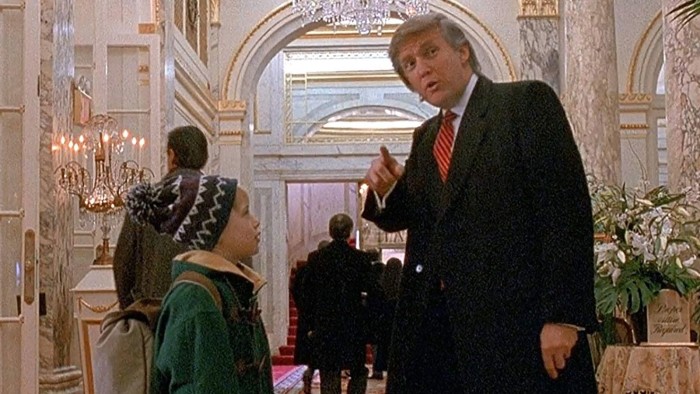Unlock the White House Watch newsletter for free
Your guide to what the 2024 US election means for Washington and the world
Will the latest iteration of the Trump administration’s supercharged “flood the zone with sh*t” strategy be a global macroeconomic mega-deal — an agreement that outdoes even the famous 1985 Plaza Accord in ambition?
That was a deal between the US and its major trading partners struck at the Plaza Hotel (of Home Alone 2: Lost in New York fame) to engineer a dollar devaluation, after Fed chair Paul Volcker’s war on inflation had sent the greenback soaring. It was a notable success, in an era of damp-squib international agreements.

Donald Trump (also of Home Alone 2: Lost in New York fame) already demonstrated an affinity for economic history by purchasing the Plaza Hotel in 1988 (the deal ended up in bankruptcy). He really wants a weaker dollar. Conveniently, he also owns the Mar-a-Lago resort in Florida, which might be a profitable good venue for a new accord.
Versions of the “Mar-a-Lago Accord” idea have therefore been floating around ever since the first Trump presidency. His victory in November naturally led them to resurface. Alphaville mentioned the possibility in our how-to-devalue-the-dollar guide the day after the 2024 election.
The chatter then died down, but has now apparently come back on the news agenda. Most of the basic contours of the supposed plan seem to be derived from this November 2024 paper by Stephen Miran.
Miran is currently a senior strategist at Hudson Bay Capital, but he served a stint in the US Treasury during the first Trump administration, and is now Trump’s nominee for chair of the Council of Economic Advisors. And you can’t fault his ambition:
The next Trump term presents potential for sweeping change in the international economic system and possible accompanying volatility. It is important for investors to understand the tools that might be employed for such purposes, as well as the means by which government may attempt to avoid unwelcome consequences. This essay attempts to provide a user’s guide: a survey of some tools, their economic and market consequences, and steps that can be taken to mitigate unwanted side effects.
Wall Street consensus that an Administration has no means by which to affect the foreign exchange value of the dollar, should it desire to do so, is wrong. Government has many means of doing so, both multilaterally and unilaterally. No matter what approach it takes, however, attention must be paid to steps to minimise volatility. Assistance from trading partners or the Federal Reserve can be helpful in doing so.
In any case, because President Trump has shown tariffs are a means by which he can successfully extract negotiating leverage — and revenue — from trading partners, it is quite likely that tariffs are used prior to any currency tools. Because tariffs are USD-positive, it will be important for investors to understand the sequencing of reforms to the international trading system. The dollar is likely to strengthen before it reverses, if it does so.
There is a path by which the Trump Administration can reconfigure the global trading and financial systems to America’s benefit, but it is narrow, and will require careful planning, precise execution, and attention to steps to minimise adverse consequences.
It is tempting to discount the whole thing, as this is a ~cough~ freewheeling administration with a multitude of hangers-on throwing policy proposals around like confetti. Some aspects — such as forcing countries to swap their Treasuries for century bonds — seem a bit fantastical. It’s essentially a glorified protection racket scheme with some lipstick.
Even Miran noted that restructuring the global financial system will require “careful planning, precise execution and attention to steps to minimise adverse consequences”. And, let’s face it, these aren’t qualities that the first or (thus far) second Trump administrations have demonstrated a lot of.
Moreover, the world is a radically different place today than it was back when the original Plaza Accord was struck in 1985. Mark Sobel, a former US Treasury grandee, wrote in December that a Mar-a-Lago Accord was “far-fetched and implausible”.
However, the chatter can’t be ignored completely. The Trump administration has clearly shown a remarkable willingness to slap tariffs on friends and eject them from its security blanket. China has its own struggles right now.
Some countries might therefore be willing to swallow some sort of Mar-a-Lago Accord to avoid the drama. As Stephen Jen of Eurizon SLJ wrote last month:
We agree that the conditions are not ripe now for a Mar-a-Lago Accord, but the circumstances could change in 2-3 quarters’ time. Also, our sense is that Beijing’s aversion to participating in such a co-ordinated effort to drive down the dollar may not be as strong as before, especially when threatened with punitive tariffs.
John Connally — US Treasury Secretary in 1971 — famously said, ‘The dollar is our currency, but it is your problem.’ While this quote is still valid, the Plaza Accord in 1985 was an episode where other stakeholders participated to right a wrong in the dollar’s value. The interventions in 2000 to purchase euros was a similar agreement, which also addressed a stark imbalance in currency markets.
Given how mispriced the dollar is now, we believe the probability of a Mar-a-Lago Accord will rise in the coming quarters.
https://www.ft.com/content/1e19165e-1096-4aad-bf08-42132f7a3239


